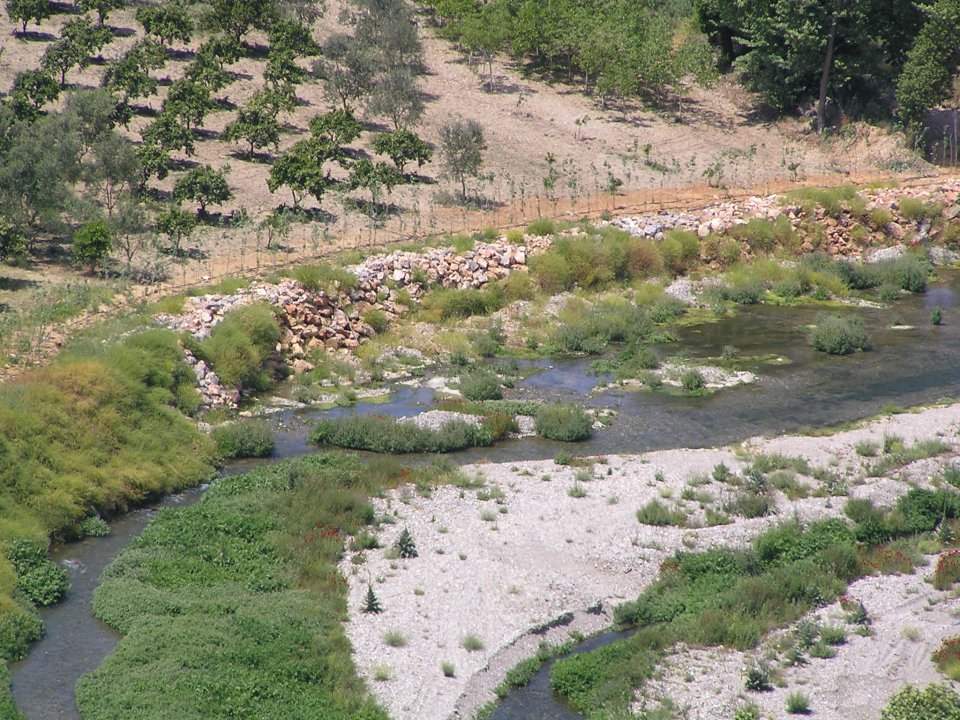
Evrotas River Basin is a predominantly rural river that has intensive water quantity and quality problems due to over utilization of the water for irrigation and intense agricultural pollution. During November of 2007, intensive precipitation with total accumulations of up to 600 mm fall over the watershed in a period of a week resulting in significant erosion and damage to infrastructure. Significant river bank erosion occurred during that event as well as significant damage of the Evrotas riparian forest. As part of the LIFE-EnviFriendly Project, 120 m of river bank length of an agricultural field was restored near the City of Sparta. The restoration was comprised of s stone hedge combined with a riparian forest restoration.
The objective of the LIFE-EnviFriendly project was to demonstrate low cost, nature based solutions that if used by all farmers within a watershed it will improve the water quality of the waters significantly. The NBS used in this case was a riparian forest restoration coupled with a river bank erosion protection.
A bank restoration system using large stones following the rivers curvatures to stabilize the bank and the riparian zone from future flood events was designed and constructed. The selection of large (80cm diameter) stones was made for two reasons: they can alleviate the power of future floods as well as allowing space for fish to spawn. The length of the stone hedge was 120m, the width 2.5m at the bottom and 1 m at the top, and the height 3.5m. In addition, we planted a riparian forest of 200 poplar trees to decrease nutrient loads due to uptake and enhanced denitrification. The trees were planted in two rows about 1.5 m apart and the spacing between them was also 1.5 m. In this way, phytoremediation in conjunction with river bank erosion controls can be demonstrated as a combined Nature Based Solution for nutrients pollution. Multi-level wells were installed up- and down-gradient from the poplar trees to determine the changes in groundwater quality.
The bank erosion was restored using a stone hedge of large boulders and moreover a riparian forest of 200 poplar trees was planted. The collected data from the monitoring of ground water quality allowed for the estimation of the nitrate reduction taking place at the riparian zone. Denitrification was not expected to contribute significantly in the reduction of nitrates due to the relative high dissolved oxygen and redox potential. Therefore the potential reduction is attributed to poplar tree uptake. The nitrate flux reduction was calculated for the length of the riparian zone for two equally divided parts. The water flow was calculated from the piezometric gradient between the wells, and then the difference between the concentrations resulted in the calculation of the flux. On the average, the riparian forest provided a 70% reduction of nitrates in the groundwater. Consequently, phytoremediation in conjunction with river bank erosion controls is suggested as a combined efficient nature based solution, low cost – high gain, for non-point source pollution of nutrients.
The Riparian Forest Restoration as a Nature Based Solution, ten years after implementation the river bank was stabilized and the riparian forest was restored and as a result we had
- Increase Biodiversity.
- Increase quality and quantity of green and blue infrastructures.
- Improve connectivity and functionality of green and blue infrastructures.
- Carbon sequestration and storage.
The benefits from the NBS include improvement in riparian resilience to floods, protection of agriculture, enhanced biodiversity, groundwater quality improvement and adaptation to climate change impacts.
This NBS can promoted and “subsidized” by Common Agricultural Policy because it improves the quality of groundwater.
- Increase infiltration / Water storage
- Increasing infiltration
- Reduce drought risk
- Carbon sequestration and storage
- Improve connectivity and functionality of green and blue infrastructures
- Increase Biodiversity
- Increase quality and quantity of green and blue infrastructures
- Improve water quality
The demonstrated NBS is low cost-high impact solution that can be easily be adapted to other rivers. However, there are significant barriers that prevent wide spread implementation.
Policy/Legislation Barriers:
- Before any action, legislation requires to establish the floodplain of the reach for the 1 in 50 years flood. This means that the farmer should obtain the following studies: topographic, hydrologic, hydraulic studies – erosion control studies –forest restoration study – environmental impacts study.
- The studies are approved and permits should be obtained from the Municipality, the Region (three Departments – water, environment and forestry), the Ministry of Environment
Financial Barriers – who pays the bill? The cost for every 100 m restoration is about 10000 €, however, at least another 10000 € for the floodplain study and the permits.
Technological Barriers– who decides which technology to use? Rip-Rap vs Rip-Rap and riparian forest.
Market and Communication -
- No established market for NBS solutions
- NBS is not part of the communication language and everyday consideration of both the public and private sector
- No promotion
The NBS Benefits were the following:
- The riparian forest enhanced the stabilization of the river bank
- Restoration of riparian forest - the forest was naturally extended to close the gap of riparian vegetation created by the flood.
- The riparian forest reduced nitrate-N pollution to river by 70%
LIFE project are financed by 50% by EU funding and 50% by Greek funding
Nikolaos Nikolaidis, Technical University of Crete, School of Environmental Engineering, University Campus, 73100 Chania, Greece






